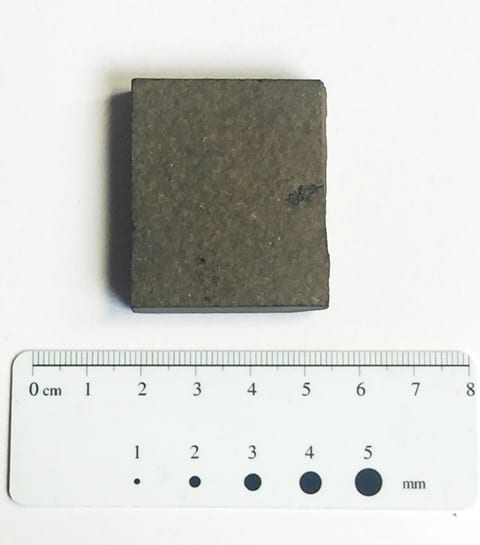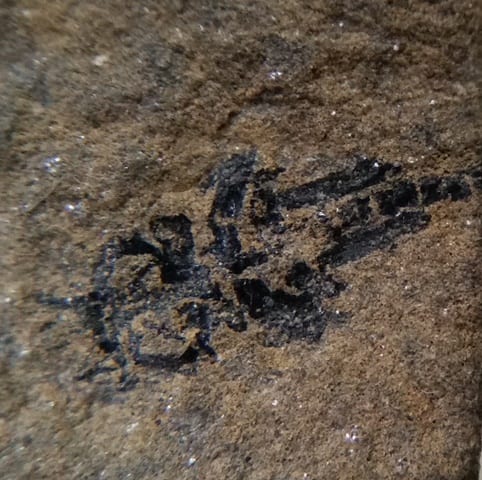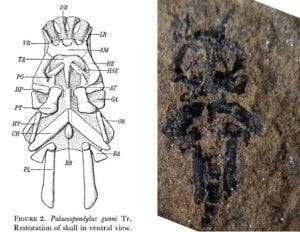Underwhelming Fossil Fish of the Month October 2016
By Mark Carnall, on 31 October 2016
Today, Monday the 31st of October 2016, is a very special day and I can’t believe we’ve managed to co-ordinate October’s Underwhelming Fossil Fish of the Month, a monthly foray into the Grant Museum’s vast collection of underwhelming fish fossils, to go out on the exact date.
Exactly, precisely on this day 419.2 million years ago, give or take 3 million years, the Devonian Period began marking the beginning of the Age of Fishes.
Since the Devonian Period, fish have been the most dominant group of vertebrates on the planet, accounting for about half of all described vertebrate species today. Controversially, mammals have tried to claim that the key events in their evolutionary history warrant their own ages, however, the legitimacy of the alleged ‘Age of Reptiles‘ and so-called ‘Age of Mammals‘ are not officially recognised outside of human communities. Today, we are still very much in the Age of Fishes and in order to celebrate such a key date, in typical UFFotM style, we’ve not really gone for anything special at all actually. This month’s fossil fish is of Devonian age, but aside from just being a coincidence, as I’ve just demonstrated, technically we are all of Devonian age.
Take some time out of your Age of Fishes, #DevonianDay celebrations and have a look at this underwhelming fossil fish.

They say that good things come in small packages. But then there’s LDUCZ-V1018 Palaeospondylus gunni so what do ‘they’ know. It’s the return of moon phases scale bar!
For those of you who maintain the Underwhelming Fossil Fish of the Month Wiki, Underwhelming Fossil Fish of the Monthipedia, this is the smallest fossil fish that has been featured in this series. This month’s fossil is the tiny black smear on the right hand side, not be confused with the equally unimpressive black smear at the bottom or indeed the rock matrix which is arguably as interesting. Here’s a close up, aforementioned Monthipedians, please note this is not a return of the reassuringly inexpensive yet perpetually dissappointing USB microscope, as the image quality no doubt indicates.
Although it may not look like much, this is actually exactly how Palaeospondylus gunni fossils normally look. According to the label information, this specimen was collected in 1966 from Achannaras, Scotland a Site of Special Scientific Interest designated of importance for its Devonian fossil fish specimens. This whippersnapper is 380 million years old.
Preservation What we have here, is the head region of Palaeospondylus gunni and despite the small size, there’s enough detail to know that this is probably the ventral aspect of the head (so we are seeing the head from underneath).
With such astonishing detail discernable in this tiny specimen, we can see why Achanarras is a protected site. All of the elements labelled on the figure on the left have bizarre names; ampyx, tauidion, gammation and rostral apparatus. The reason for such odd names, is because until recently, nobody knew what these were. As for what all these bits do in the head is a question that has puzzled generations of palaeontologists. FAIR WARNING, we’re skirting the borders of whelming territory with this one.
Research As hinted above, Palaeospondylus gunni is an enigmatic animal, despite many known and well preserved fossils. Since its description by Underwhelming Fossil Fish luminary Traquair in 1890, numerous palaeontologists have had a go at trying to work out what kind of animal these fossils represent. Traquair and others, proposed that Palaeospondylus was a jawless fish, related to today’s lampreys and hagfish. It has also been suggested to be a larval lungfish (Miller 1930), ‘Darwin’s bulldog’, Thomas Henry Huxley thought it was one of the armoured fishes and perhaps a larval Coccosteus (Moy-Thomas 1940), Dean thought it might be an ancient chimaera (Dean 1904) and in 1926 a possible herring relationship was proposed (Kyle 1926) meaning Palaeospondylus has been tied to almost every major fish group at one point or another.
From the publication titles alone, you can get a sense of the frustration that some palaeontologists seem to have with this species; Is Palaeospondylus a Cyclostome? (Dean 1896), Still another memoir on Palaeospondylus (Dean 1904), The Puzzle of “Palaeospondylus” (Thomson 1992) and A Palaeontological Puzzle Solved? (Thomson 2004).
In 2004, the case was apparently settled, Palaeospondylus is a larval lungfish or oldest known vertebrate parasite…. (Thomson 2004).
In Society Writing in 1940, Moy-Thomas opens a paper with “The little fish, Palaeospondylus gunni […] is perhaps the most widely known of all problematical fossils”. Which may have been true at the time, but its not like people in 1940s had any major world spanning events to otherwise distract people. I feel that today, there’s perhaps less widely known of all problematical fossils. That’s why on #DevonianDay I implore you to use the word Palaeospondylus whenever there is ambiguity or an element of indecision. Don’t know what to have for tea? Classic Palaeospondylus. The secret formula for Coca-Cola or Big Mac sauce? There’s definitely some Palaeospondylus. Where is Lord Lucan? Has anyone checked Palaeospondylus? Struggling to sum up the ramifications of the UK leaving the EU? Well that’s clearly Palaeospondylus.
Palaeospondylus gunni
Preservation 9
Research Palaeospondylus
Society 0
Underwhelmingness 3
UPDATE: 31/10/2016 Corrected UNITALICISED BINOMIALS. The editing team have all been fired immediately.
References
Dean, B. 1896 Is Palaeospondylus a Cyclostome? Trans. N.Y. Acad. Sci.15, 101-104.
Dean, B. 1904 Still another memoir on Palaeospondylus. Science, n.s.19, 425-426.
Kyle, H. M. 1926 The Biology of Fishes, pp. 209-211. London.
Miller, A. E. 1930 Note on the tail skeleton of Lepidosiren paradoxa, with remarks on the affinities of Palaeospondylus. Proc. Zool. Soc. Lond. pp. 783-789
Moy-Thomas, J. A. 1940. The Devonian Fish Palaeospondylus Gunni Traquair. Philosophical Transactions of the Royal Society of London. Series B, Biological Sciences, vol. 230, no. 573, pp. 391–413.
Thomson, K.S. 1992. “Marginalia: The Puzzle of ‘Palaeospondylus.’” American Scientist, vol. 80, no. 3, pp. 216–219.
Thomson, K.S. 2004. “Marginalia: A Palaeontological Puzzle Solved?” American Scientist, vol. 92, no. 3, pp. 209–211.
Mark Carnall is the Collections Manager (Life Collections) at the Oxford University Museum of Natural History, and former Curator of the Grant Museum
7 Responses to “Underwhelming Fossil Fish of the Month October 2016”
- 1
-
2
Fossil Friday Roundup: November 4, 2016 | PLOS Blogs Network wrote on 4 November 2016:

[…] (Notions of a Most Peculiar Dinosaur Nerd) Underwhelming Fossil Fish of the Month October 2016 (UCL Blogs) The Biggest Sabercat (Laelaps) A Dinosaur Brain? (Dr. Neurosaurus) Mesozoic Miscellany 88 (Love in […]
-
3
Daniel wrote on 25 November 2016:
Palaeospondylus my caudal peduncle! It’s clearly a fossilised smurf!
-
4
Underwhelming fossil fish of the Month December 2016 | UCL Museums & Collections Blog wrote on 31 December 2016:

[…] In August, I bored us (stoppit!) with an odus to Gyrodus. September was just okay actually. After an enigmatic October, November rolled right into the end of the world and the fish with no name. Which brings us neatly […]
-
5
Untangling Scotland’s Century-Previous Fossil Fish Thriller – Dinner Get News wrote on 20 June 2022:

[…] or boogeyman. It’s been a boogeyman amongst paleontologists ever since (although typically a boring one), with weird options which have defied straightforward […]
-
6
Untangling Scotland's Century-Old Fossil Fish Mystery – extension 13 wrote on 20 June 2022:

[…] a bugbear, or boogeyman. It’s been a boogeyman among paleontologists ever since (though often a dull one), with bizarre features that have defied easy […]
-
7
Untangling Scotland’s Century-Old Fossil Fish Mystery – Tech Lowdown wrote on 20 June 2022:

[…] a bugbear, or boogeyman. It’s been a boogeyman among paleontologists ever since (though often a dull one), with bizarre features that have defied easy […]
 Close
Close




This is superb! Definitely my favourite fish to date.
As for wrestling with the problem of what it actually is, though you did a fine job summarising the academic literature, I feel you overlooked the masses of cave drawings dedicated to understanding this fish, often mistakenly ascribed to early drawings of aliens and time travelling astronauts. (Those conspiracy crazies always overlook the obvious, in this case the glaringly obvious diagrams illustrating discussions on whether Palaeospondylus was a hagfish or lungfish.)